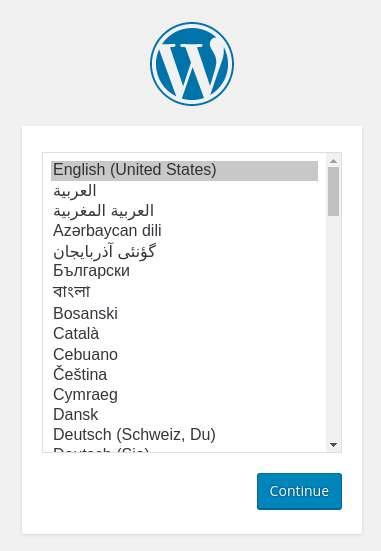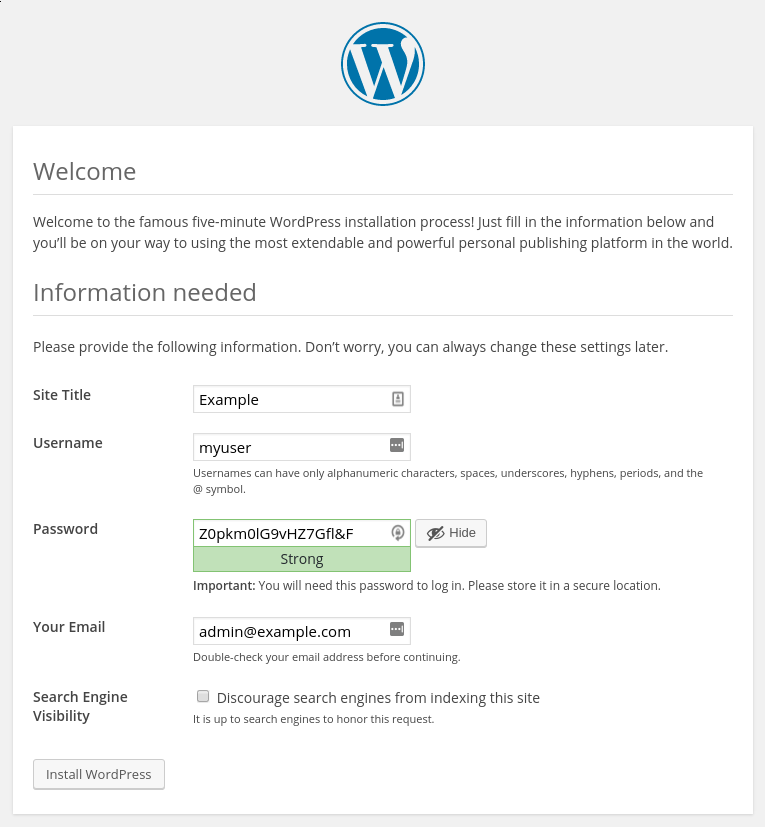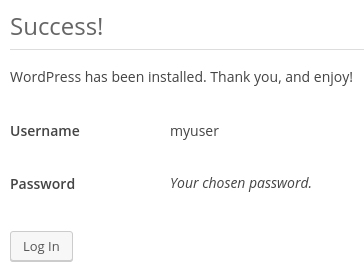- Log in to:
- Community
- DigitalOcean
- Sign up for:
- Community
- DigitalOcean
By Lyn Muldrow and Anish Singh Walia
Not using Ubuntu 20.04?
Choose a different version or distribution.
Introduction
WordPress, one of the most popular content management systems (CMS) on the internet currently, allows users to set up flexible blogs and websites using a MySQL backend with PHP processing. WordPress has seen an incredible adoption rate among new and experienced engineers alike and is a great choice for getting a website up and running efficiently. After an initial setup, almost all administration for WordPress websites can be done through its graphical interface— these features and more make WordPress a great choice for websites built to scale.
In this tutorial, you’ll focus on getting an instance of WordPress set up on a LEMP stack (Linux, Nginx, MySQL, and PHP) for an Ubuntu server.
How to Install WordPress with LEMP on Ubuntu
- Creating a MySQL Database and User for WordPress
- Installing Additional PHP Extensions
- Configuring Nginx
- Downloading WordPress
- Setting up the WordPress Configuration File
- Completing the Installation Through the Web Interface
Prerequisites
In order to complete this tutorial, you’ll need access to an Ubuntu server. To successfully install WordPress with LEMP on your server, you’ll also need to perform the following tasks before starting this tutorial:
-
Create a
sudouser on your server: The steps in this tutorial are using a non-root user withsudoprivileges. You can create a user withsudoprivileges by following our Ubuntu initial server setup tutorial. -
Install a LEMP stack: WordPress needs a web server, a database, and PHP to function correctly. Setting up a LEMP stack (Linux, Nginx, MySQL, and PHP) fulfills all of these requirements. Follow this tutorial to install and configure this software.
Note: Rather than setting up these components yourself, you can quickly provision an Ubuntu server that already has a LEMP stack installed with DigitalOcean’s LEMP 1-click install app.
Be aware, though, that this tutorial still assumes you have an administrative sudo user and an Nginx server block configured on your server. Even with a server provisioned with the LEMP 1-click app, you’ll need to follow Steps 1, 2, 3, and 5 of our Ubuntu initial server setup tutorial. You’ll also need to complete Step 4 of our guide on installing the LEMP Stack on Ubuntu to configure an Nginx server block and configure Nginx to use the PHP Processor
-
Secure your site with SSL: WordPress serves dynamic content and handles user authentication and authorization. TLS/SSL is the technology that allows you to encrypt the traffic from your site so that your connection is secure. The way you set up SSL will depend on whether you have a domain name for your site.
-
If you have a domain name, the easiest way to secure your site is with Let’s Encrypt, which provides free, trusted certificates. Follow our Let’s Encrypt guide for Nginx to set this up.
-
If you do not have a domain and you’re using this configuration for testing or personal use, you can use a self-signed certificate instead. This provides the same type of encryption but without the domain validation. Follow our self-signed SSL guide for Nginx to get set up.
When you are finished with setup, log in to your server as the sudo user to continue.
Step 1 — Creating a MySQL Database and User for WordPress
WordPress uses MySQL to manage and store site and user information. Although you already have MySQL installed, let’s create a database and a user for WordPress to use.
To get started, log in to the MySQL root (administrative) account. If MySQL is configured to use the auth_socket authentication plugin (which is default), you can log in to the MySQL administrative account using sudo:
- sudo mysql
If you have changed the authentication method to use a password for the MySQL root account, use the following command instead:
- mysql -u root -p
You will be prompted for the password you set for the MySQL root account.
Once logged in, create a separate database that WordPress can control. You can call this whatever you would like, but we will be using wordpress in this guide to keep it simple. You can create a database for WordPress by entering:
- CREATE DATABASE wordpress DEFAULT CHARACTER SET utf8 COLLATE utf8_unicode_ci;
Note: Every MySQL statement must end in a semi-colon (;). If you’ve encountered an error, check to make sure the semicolon is present.
Next, let’s create a separate MySQL user account that we will use exclusively to operate on our new database. Creating single-purpose databases and accounts is a good idea from a management and security standpoint. We’ll use the name wordpressuser in this guide — feel free to change this if you’d like.
In the following command, you are going to create an account, set a password, and grant access to the database you created. Remember to choose a strong password here:
-
- CREATE USER 'wordpressuser'@'localhost' IDENTIFIED BY 'password';
-
- GRANT ALL ON wordpress.* TO 'wordpressuser'@'localhost';
You now have a database and user account, each made specifically for WordPress.
With the database tasks complete, let’s exit out of MySQL by typing:
- EXIT;
The MySQL session will exit, returning you to the regular Linux shell.
Step 2 — Installing Additional PHP Extensions
When setting up the LEMP stack, it required a very minimal set of extensions to get PHP to communicate with MySQL. WordPress and many of its plugins leverage additional PHP extensions, and you’ll use a few more in this tutorial.
Let’s download and install some of the most popular PHP extensions for use with WordPress by typing:
- sudo apt update
- sudo apt install php-curl php-gd php-intl php-mbstring php-soap php-xml php-xmlrpc php-zip
Note: Each WordPress plugin has its own set of requirements. Some may require additional PHP extension packages to be installed. Check your plugin documentation to discover its PHP requirements. If they are available, they can be installed with apt as demonstrated above.
When you are finished installing the extensions, restart the PHP-FPM process so that the running PHP processor can leverage the newly installed features:
- sudo systemctl restart php7.4-fpm
You now have all of the PHP extensions needed, installed on the server.
Step 3 — Configuring Nginx
Next, let’s make a few adjustments to our Nginx server block files. Based on the prerequisite tutorials, you should have a configuration file for your site in the /etc/nginx/sites-available/ directory configured to respond to your server’s domain name or IP address and protected by a TLS/SSL certificate. We’ll use /etc/nginx/sites-available/wordpress as an example here, but you should substitute the path to your configuration file where appropriate.
Additionally, we will use /var/www/wordpress as the root directory of our WordPress install in this guide. Again, you should use the web root specified in your own configuration.
Note: It’s possible you are using the /etc/nginx/sites-available/default default configuration (with /var/www/html as your web root). This is fine to use if you’re only going to host one website on this server. If not, it’s best to split the necessary configuration into logical chunks, one file per site.
Open your site’s server block file with sudo privileges to begin:
- sudo nano /etc/nginx/sites-available/wordpress
Within the main server block, let’s add a few location blocks.
Start by creating exact-matching location blocks for requests to /favicon.ico and /robots.txt, both of which you do not want to log requests for.
Use a regular expression location to match any requests for static files. We will again turn off the logging for these requests and will mark them as highly cacheable, since these are typically expensive resources to serve. You can adjust this static files list to contain any other file extensions your site may use:
server {
. . .
location = /favicon.ico { log_not_found off; access_log off; }
location = /robots.txt { log_not_found off; access_log off; allow all; }
location ~* \.(css|gif|ico|jpeg|jpg|js|png)$ {
expires max;
log_not_found off;
}
. . .
}
Inside of the existing location / block, let’s adjust the try_files list. Comment out the default setting by prepending the line with a pound sign (#) and then add the highlighted line. This way, instead of returning a 404 error as the default option, control is passed to the index.php file with the request arguments.
This should look something like this:
server {
. . .
location / {
#try_files $uri $uri/ =404;
try_files $uri $uri/ /index.php$is_args$args;
}
. . .
}
When you are finished, save and close the file.
Now, let’s check our configuration for syntax errors by typing:
- sudo nginx -t
If no errors were reported, reload Nginx by typing:
- sudo systemctl reload nginx
Next, let’s download and set up WordPress.
Step 4 — Downloading WordPress
Now that your server software is configured, let’s download and set up WordPress. For security reasons, it is always recommended to get the latest version of WordPress directly from the project’s website.
Change into a writable directory and then download the compressed release by typing:
- cd /tmp
This changes your directory to the temporary folder. Then, enter the following command to download the latest version of WordPress in a compressed file:
- curl -LO https://wordpress.org/latest.tar.gz
Note: The -LO flag is used to get directly to the source of the compressed file. -L ensures that fetching the file is successful in the case of redirects, and -O writes the output of our remote file with a local file that has the same name. To learn more about curl commands, visit How to Download Files with cURL
Extract the compressed file to create the WordPress directory structure:
- tar xzvf latest.tar.gz
You will be moving these files into our document root momentarily, but before you do, let’s copy over the sample configuration file to the filename that WordPress actually reads:
- cp /tmp/wordpress/wp-config-sample.php /tmp/wordpress/wp-config.php
Now, let’s copy the entire contents of the directory into our document root. We’re using the -a flag to make sure our permissions are maintained, and a dot at the end of our source directory to indicate that everything within the directory should be copied (including hidden files):
- sudo cp -a /tmp/wordpress/. /var/www/wordpress
Now that our files are in place, you’ll assign ownership to the www-data user and group. This is the user and group that Nginx runs as, and Nginx will need to be able to read and write WordPress files in order to serve the website and perform automatic updates:
- sudo chown -R www-data:www-data /var/www/wordpress
Files are now in the server’s document root and have the correct ownership, but you still need to complete some additional configuration.
Step 5 — Setting up the WordPress Configuration File
Next, let’s make some changes to the main WordPress configuration file.
When you open the file, you’ll start by adjusting some secret keys to provide some security for our installation. WordPress provides a secure generator for these values so that you don’t have to come up with values on your own. These are only used internally, so it won’t hurt usability to have complex, secure values here.
To grab secure values from the WordPress secret key generator, type:
- curl -s https://api.wordpress.org/secret-key/1.1/salt/
You will get back unique values that look something like this:
Warning: It is important that you request unique values each time. Do NOT copy the values shown below!
Outputdefine('AUTH_KEY', '1jl/vqfs<XhdXoAPz9 DO NOT COPY THESE VALUES c_j{iwqD^<+c9.k<J@4H');
define('SECURE_AUTH_KEY', 'E2N-h2]Dcvp+aS/p7X DO NOT COPY THESE VALUES {Ka(f;rv?Pxf})CgLi-3');
define('LOGGED_IN_KEY', 'W(50,{W^,OPB%PB<JF DO NOT COPY THESE VALUES 2;y&,2m%3]R6DUth[;88');
define('NONCE_KEY', 'll,4UC)7ua+8<!4VM+ DO NOT COPY THESE VALUES #`DXF+[$atzM7 o^-C7g');
define('AUTH_SALT', 'koMrurzOA+|L_lG}kf DO NOT COPY THESE VALUES 07VC*Lj*lD&?3w!BT#-');
define('SECURE_AUTH_SALT', 'p32*p,]z%LZ+pAu:VY DO NOT COPY THESE VALUES C-?y+K0DK_+F|0h{!_xY');
define('LOGGED_IN_SALT', 'i^/G2W7!-1H2OQ+t$3 DO NOT COPY THESE VALUES t6**bRVFSD[Hi])-qS`|');
define('NONCE_SALT', 'Q6]U:K?j4L%Z]}h^q7 DO NOT COPY THESE VALUES 1% ^qUswWgn+6&xqHN&%');
These are configuration lines that you can paste directly in your configuration file to set secure keys. Copy the output you received now.
Now, open the WordPress configuration file:
- sudo nano /var/www/wordpress/wp-config.php
Find the section that contains the dummy values for those settings. It will look something like this:
. . .
define('AUTH_KEY', 'put your unique phrase here');
define('SECURE_AUTH_KEY', 'put your unique phrase here');
define('LOGGED_IN_KEY', 'put your unique phrase here');
define('NONCE_KEY', 'put your unique phrase here');
define('AUTH_SALT', 'put your unique phrase here');
define('SECURE_AUTH_SALT', 'put your unique phrase here');
define('LOGGED_IN_SALT', 'put your unique phrase here');
define('NONCE_SALT', 'put your unique phrase here');
. . .
Delete those lines and paste in the values you copied from the command line:
. . .
define('AUTH_KEY', 'VALUES COPIED FROM THE COMMAND LINE');
define('SECURE_AUTH_KEY', 'VALUES COPIED FROM THE COMMAND LINE');
define('LOGGED_IN_KEY', 'VALUES COPIED FROM THE COMMAND LINE');
define('NONCE_KEY', 'VALUES COPIED FROM THE COMMAND LINE');
define('AUTH_SALT', 'VALUES COPIED FROM THE COMMAND LINE');
define('SECURE_AUTH_SALT', 'VALUES COPIED FROM THE COMMAND LINE');
define('LOGGED_IN_SALT', 'VALUES COPIED FROM THE COMMAND LINE');
define('NONCE_SALT', 'VALUES COPIED FROM THE COMMAND LINE');
. . .
Next, let’s modify some of the database connection settings at the beginning of the file. You’ll have to adjust the database name, the database user, and the associated password that was configured within MySQL.
The other change you should make is to set the method that WordPress uses to write to the filesystem. Since you’ve given the web server permission to write where it needs to, you can explicitly set the filesystem method to “direct”. Failure to set this with our current settings would result in WordPress prompting for FTP credentials when we perform some actions. Add this setting below the database connection settings, or anywhere else in the file:
. . .
define( 'DB_NAME', 'wordpress' );
/** MySQL database username */
define( 'DB_USER', 'wordpressuser' );
/** MySQL database password */
define( 'DB_PASSWORD', 'password' );
. . .
define( 'FS_METHOD', 'direct' );
Save and close the file when you’re done.
Step 6 — Completing the Installation Through the Web Interface
Now that the server configuration is complete, you can finish up the installation through WordPress’ web interface.
In your web browser, navigate to your server’s domain name or public IP address:
http://server_domain_or_IP/wordpress
Select the language you would like to use:

Next, you will come to the main setup page.
Select a name for your WordPress site and choose a username (it is recommended not to choose something like “admin” for security purposes). A strong password is generated automatically. Save this password or select an alternative strong password.
Enter your email address and select whether you want to discourage search engines from indexing your site:

When you click ahead, you will be taken to a page that prompts you to log in:

Once you log in, you will be taken to the WordPress administration dashboard:

Conclusion
WordPress should be installed and ready to use! Some common next steps are to choose the permalinks setting for your posts (can be found in Settings > Permalinks) or to select a new theme (in Appearance > Themes). If this is your first time using WordPress, explore the interface a bit to get acquainted with your new CMS.
If you’re looking for a one-click solution to install a WordPress Droplet, learn more about the WordPress One-Click App.
Thanks for learning with the DigitalOcean Community. Check out our offerings for compute, storage, networking, and managed databases.
Tutorial Series: Getting Started With WordPress
WordPress powers over 33% of the web and is a trusted, open source content management system that is unparalleled in performance and extendability. In this series, learn more about WordPress and how to install, configure, and optimize WordPress sites.
Browse Series: 5 tutorials
About the author(s)
Software engineer, writer, and speaker who loves solving problems and educating the next generation.
I help Businesses scale with AI x SEO x (authentic) Content that revives traffic and keeps leads flowing | 3,000,000+ Average monthly readers on Medium | Sr Technical Writer @ DigitalOcean | Ex-Cloud Consultant @ AMEX | Ex-Site Reliability Engineer(DevOps)@Nutanix
Still looking for an answer?
This textbox defaults to using Markdown to format your answer.
You can type !ref in this text area to quickly search our full set of tutorials, documentation & marketplace offerings and insert the link!
The tutorial is missing a step to symlink site under sites-available to sites-enabled:
sudo ln -s /etc/nginx/sites-available/wordpress /etc/nginx/sites-enabled/wordpress
If the symlink to default or digitalocean is there, remove them.
When editing /etc/nginx/sites-available/wordpress file remember to use correct path for wordpress files and use the server_name with your domain name.
server {
...
root /var/www/wordpress;
server_name your_domain_name.com www.your_domain_name.com
...
}
Finally add php-imagick to php extensions list.
There is another missing in addition to one symlink as pointed in another comment. You must also install php-fpm
sudo apt install php-fpm
Всем привет. Кто знает как отключить доступ по ip на nginx? Чтобы сайт работал только на домене
With a minimal digital ocean partition this won’t work because there isn’t enough memory for mysqld. There are probably various ways to solve this but I solved it by adding a 2G swap partition.
- Table of contents
- Prerequisites
- Step 1 — Creating a MySQL Database and User for WordPress
- Step 2 — Installing Additional PHP Extensions
- Step 3 — Configuring Nginx
- Step 4 — Downloading WordPress
- Step 5 — Setting up the WordPress Configuration File
- Step 6 — Completing the Installation Through the Web Interface
- Conclusion
Deploy on DigitalOcean
Click below to sign up for DigitalOcean's virtual machines, Databases, and AIML products.
Become a contributor for community
Get paid to write technical tutorials and select a tech-focused charity to receive a matching donation.
DigitalOcean Documentation
Full documentation for every DigitalOcean product.
Resources for startups and SMBs
The Wave has everything you need to know about building a business, from raising funding to marketing your product.
Get our newsletter
Stay up to date by signing up for DigitalOcean’s Infrastructure as a Newsletter.
New accounts only. By submitting your email you agree to our Privacy Policy
The developer cloud
Scale up as you grow — whether you're running one virtual machine or ten thousand.
Get started for free
Sign up and get $200 in credit for your first 60 days with DigitalOcean.*
*This promotional offer applies to new accounts only.
